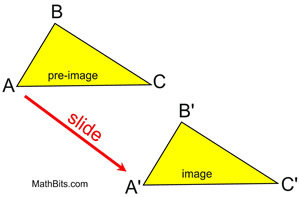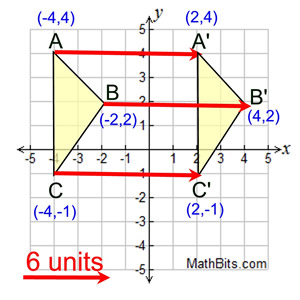|
 |
Translations are SLIDES!! |
|
A translation moves ("slides") an object a fixed distance in a given direction without changing its size or shape, and without turning it or flipping it.
• The original object is called the pre-image, and the translation is called the image.
• The image is usually labeled using a prime symbol, such as A'B'C'.
• Translations may be described by their movement, such as 5 units to the right and 2 units down.
|
 |
• An object and its translation have the same shape and size, and face in the same direction.
• In Latin, the word "translate" means "carried across".
Translations can be seen, in a variety of situations:
|
(←) Translations can be seen in nature. The hexagonal sections of a honeycomb are the same size, the same shape and face in the same direction.
(→) As you go down a slide, you are undergoing a translation. You are moving a given distance in a given direction. You do not change your size, shape or the direction in which you are facing (hopefully!).
|
|
Certain patterns of musical notes are often repeated (translated) within a composition.
|
The artist M. C. Escher continually used translations, reflections, and rotations in his famous art works. To see the works of M. C. Escher, visit
http://www.msescher.com.
|
Seats in a stadium are the same size, the same shape, and face in the same direction. |
Translations in the coordinate plane:
 Translation 6 units right: Translation 6 units right:
 |
Notice how each vertex moves the same distance in the same direction. All three vertices (A, B and C) are moved 6 units horizontally to the right.
If you move horizontally 6 units to the right, 6 is added to the x-coordinate of each of the vertices.
Translation 6 units to the right.
(x, y) → (x + 6, y) |
|
 6 units left, 3 units up: 6 units left, 3 units up:
 |
Be sure you notice where the original figure, ABCD, is located. In this graph, ABCD is on the right.
Each vertex of ABCD is moved 6 units to the left, and then 3 units up.
Translation 6 units left and 3 units up.
(x, y) → (x - 6, y + 3) |
|


NOTE: The re-posting of materials (in part or whole) from this site to the Internet
is copyright violation
and is not considered "fair use" for educators. Please read the "Terms of Use". |
|









